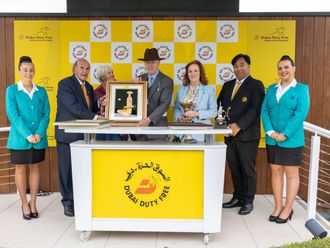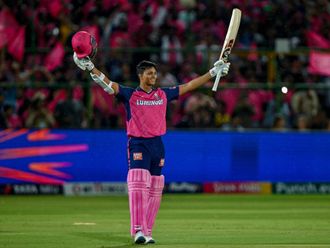Dubai: The logistics of how some of the Dubai World Cup’s stars are brought to the UAE is something of a mystery to most people. Passports, tickets and the choice of economy, business or first class need to be dealt with. But these issues aren’t just for the racegoers heading to the UAE for the Dubai World Cup, they’re for the competitors themselves.
Of the 14 entrants in last year’s running of the world’s richest horse race, nine were brought to the UAE from six countries on three continents, with some flying for more than 15 hours to get here. Add to that another 70-odd visiting horses racing in the eight undercard events, and the logistical pre-planning for a five-hour race meet can extend to months.
Here Gulf News looks at each of the stages a foreign-based horse has to go through before competing in the Dubai World Cup meeting at Meydan.
QUARANTINE
The risk of spreading disease means that permanently-imported horses are forced to stay in quarantine for between 30 and 141 days before even travelling to the UAE, depending on their country of origin.
However, horses that are brought here just to compete in the Dubai Racing Carnival and Dubai World Cup are imported under special regulations, as temporary imports are allowed to stay in the UAE for up to 90 days provided they are held in isolation.
No training disruption
This allows horses to bypass the usual quarantine requirements and travel from country to country without disruption to their training or long delays between races.
Foreign horses that come for the Dubai World Cup are stabled where they won’t mix with horses of a possible lower health status. Track timings are also controlled so they can be trained to ensure they only come into contact with similar horses.
Mandatory quarantine
If a horse is being permanently imported, a pre-departure spell in quarantine is mandatory.
The duration of stay varies based on the country of origin, because different countries are exposed to different threats.
A vet will conduct daily blood and temperature checks to test for symptoms of communicable diseases and they are released after passing the incubation period for all possible threats without showing symptoms.
After a successful stint in quarantine, a health certificate is signed off by a veterinarian, but this vital paper is only valid for 48 hours so the horse must depart within that time.
DEPARTURE
While the horse is in quarantine, the equine logistics team book freight space with a cargo carrier to ensure it reaches its destination with adequate time to prepare for the race.
Like humans, horses have passports to prove their identity and this, along with a unique 15-digit number, correlates with a micro-chip the size of a grain of rice, which is painlessly inserted into the crest of the horse’s neck at birth. This can be scanned by vets and customs officers to cross-check information ahead of clearing the horse for departure. The passport contains information on everything from the horse’s travel history and point of origin, to medical records and vaccinations.
Business class
Freight stalls — each roughly three metres long, 2.5 metres wide and 2.5 metres high — hold three horses for economy class travel, two for business class and one for first class. The cost of flying equine economy to Dubai varies from Dh25,000 from the UK to Dh45,000 from South America.
After being driven in a horse box from quarantine to the airport, the animals are loaded into their stalls from a holding stable. A variety of methods can be used to help load the horse if it objects, including blindfolds, going in backwards and even mild sedation, but 90 per cent of the time they board without any assistance.
The stalls are prepared with enough water, bedding and hay to ensure maximum comfort, and sometimes favourite stable toys are added to make the horse feel as at home as possible. No feed is given, just hay, in order to avoid the horse getting colic or abdominal pain mid-flight.
With the booking comes an Air Way Bill. This is essentially a ticket, which details the cost of freight, the exporter, the importer, the weight, number of horses to a stall, their names, age, colour and sex. Customs officials cross-check this with the passport before stamping the ticket and issuing clearance.
Once the horse is in the stall, a tug transports the freight to the plane, where it is loaded on to the aircraft.
FLIGHT
Sexes are segregated in different stalls anyway, but their positioning on the main cargo deck is also important.
Female horses go to the back of the plane, while the males stay up front so the stallions can’t smell the mares.
Fed and watered
The temperature on board is usually maintained between 12 and 18 degrees Celsius depending on the number of horses and their point of origin and destination.
One groom travels per stall of three horses and makes sure that, once secured, they are comfortable and have enough water and hay. They are specially trained to deal with bad travellers who may become unsettled mid-flight.
Before the grooms take their seats for take-off, the pilot can be briefed to use the full length of the runway so there isn’t a sudden ascent or descent that may unsettle the horses.
Once in the air, the groom can return to the stall and stay with the horses for the duration of the flight.
Dehydration
It is imperative they keep the horses hydrated during this time, because if not properly watered a 500kg horse can lose 5-10kg in weight on a long-haul flight. Australia’s Black Caviar famously makes long-haul flights to the UK wearing a lycra compression suit to avoid swelling and tissue damage brought about by dehydration, pressure change and immovability mid-flight.
ARRIVAL
On arrival in the UAE, horses are off-loaded from the stall, where a vet confirms their identity and health certification before customs clearance.
At the airport stables, they are walked around to increase blood flow and are checked for swelling. They are then transported to quarantine or isolation, where they are washed down and exercised before relaxing with the same feed and equipment as at their home stables. Permanent arrivals will stay in quarantine six days, with daily temperature and blood checks before release, while temporary horses remain isolated until departure.
The only time they will ever come into contact with horses from other countries is during the races, meaning that even after travelling to the UAE for the Dubai World Cup, they can return home to race without delay.












